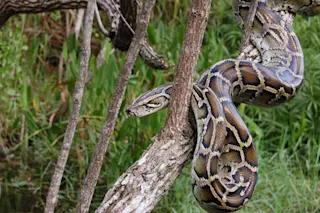Darkness has descended over Everglades National Park. Donna Kalil and her team are driving back and forth across levies and access roads in her Ford Expedition, shining spotlights towards the roads in the hopes of spotting a python that’s left cover.
Sometimes they’ll drive hours, or even days, before seeing a snake shoot across the road, camouflaged in its natural brown and pea-green patterns. When the team finds their target, they’ll sneak up and grab it close enough to the back of the head to avoid being bitten. At night the pythons are hunting so they’re less likely to realize what’s going on. Invested in their own search for prey, they don’t even realize they are the invasive prey.
“I’ve been bitten so many times,” says Kalil. “It doesn’t feel good, but the biggest threat is when they constrict around your neck or, in the case of the big ones, ...















